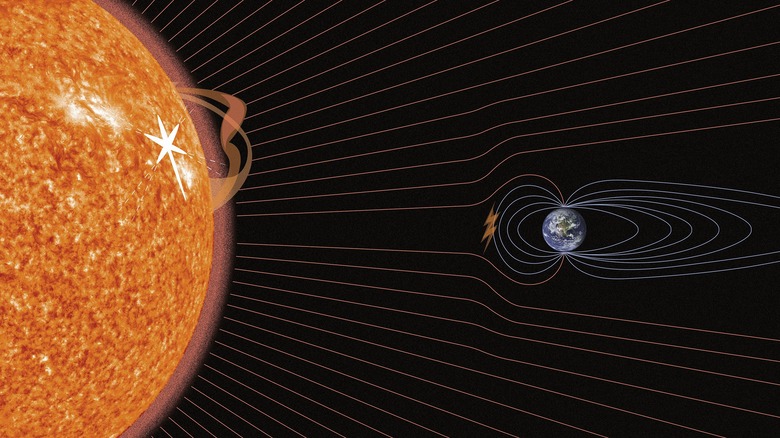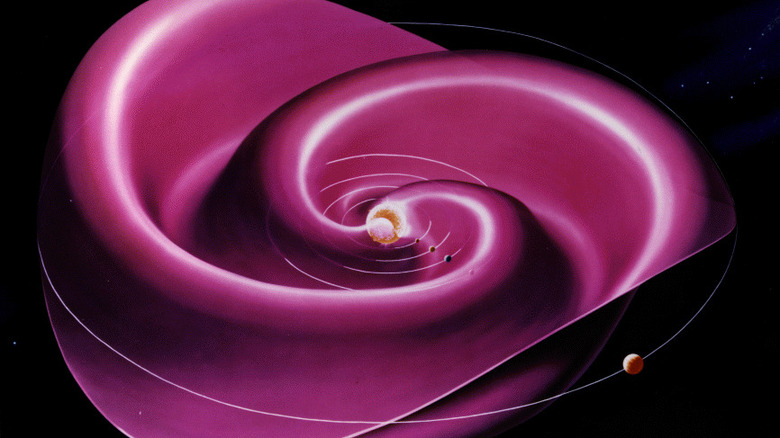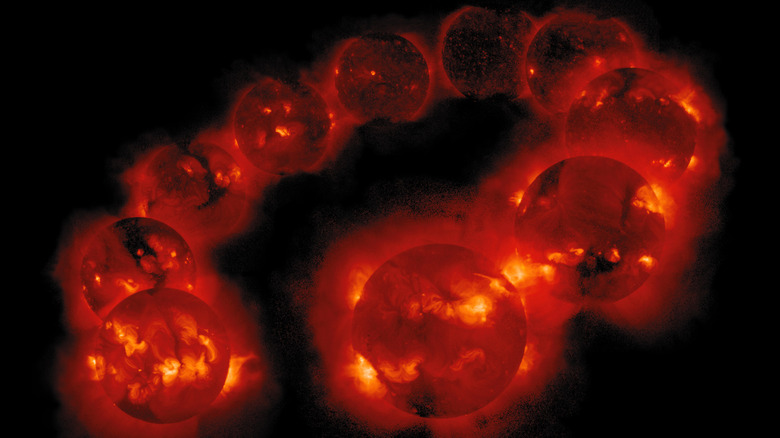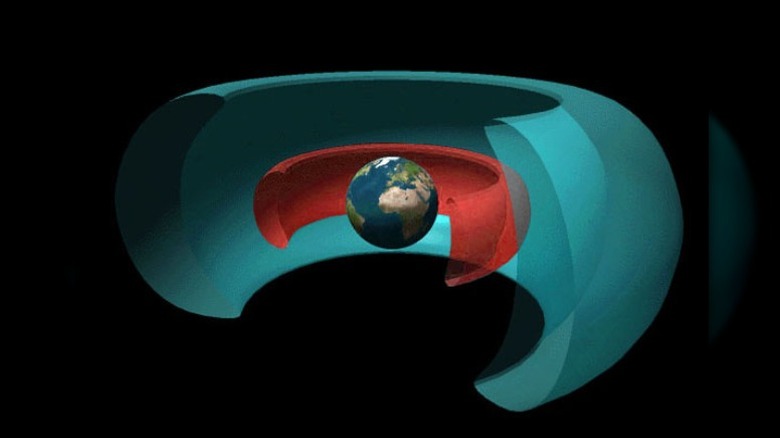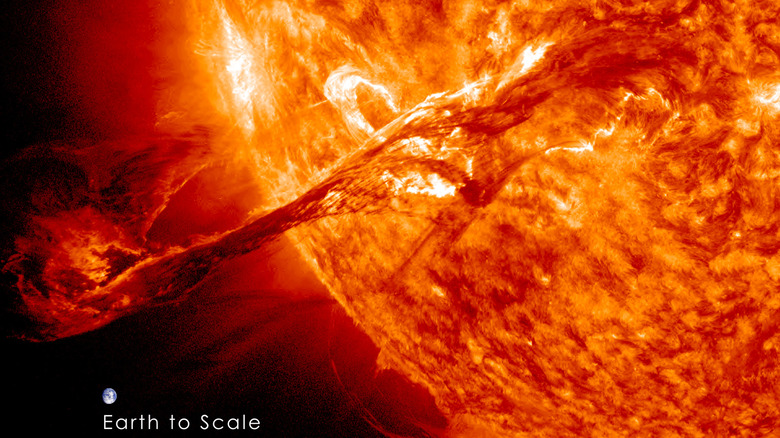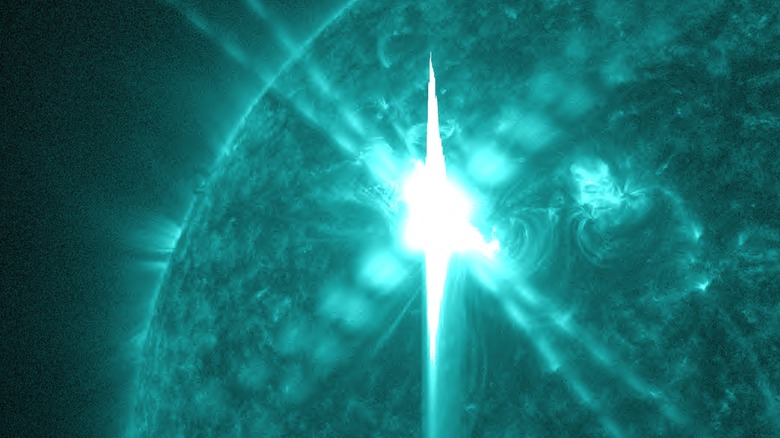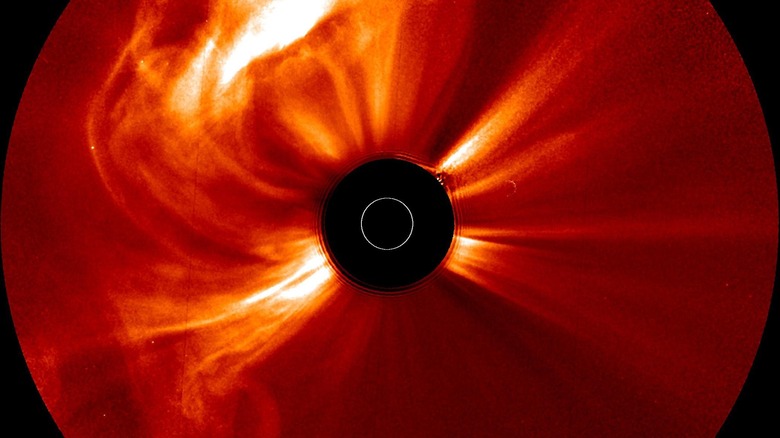The Untold Truth Of Space Weather
Most people think of space as an empty expanse of nothingness, but, in reality, space is a turbulent place full of plasma and magnetic fields. Between the planets is a sea of charged particles constantly streaming off the Sun, known as the interplanetary medium. As Universe Today explains, as well as solar plasma, it's also filled with cosmic rays and fine dust particles. While it's not a perfect vacuum, it is incredibly sparse: Just outside Earth's atmosphere, its density is just five particles in each cubic centimeter. This may not sound like anything at all, but the constantly changing interplanetary medium can have noticeable effects on our planet. These changes mean that outer space actually has weather.
With its constantly roiling surface, the Sun drives nearly everything in the solar system, and space weather is no exception. As ESA elaborates, a variety of the Sun's activity contributes to space weather, including solar wind, coronal mass ejections, and solar flares. All of these send matter and radiation sailing off the Sun's surface towards the orbiting planets. Earth is shielded from most of it, thanks to a strong magnetic field (although Mars is not so well protected, per NASA), but cosmic space storms can still have a powerful effect on our world. Here is the untold truth of space weather.
Earth is constantly buffeted by solar wind
The most basic component of space weather is the solar wind, constantly blowing off our parent star. As the University of Chicago explains, it's a constant flow of hot particles which fills the entire solar system, pouring off the Sun at speeds of around a million miles per hour. This wind comes from the Sun's corona, the absurdly hot atmosphere of the Sun, which can reach temperatures of a few million degrees. Too hot for the Sun's gravity to hold, it streams away as the solar wind, mostly a mix of protons and electrons.
The solar wind isn't uniform, either. According to NASA, the charged particles which make up the solar wind are sculpted into loops and streams by the Sun's magnetic field, varying in strength. The strongest can be found in regions known as coronal holes, where the magnetic field lines are untethered and point directly away from the Sun's surface. With its varying speed and intensity, solar wind is responsible for most of the space weather which crashes into Earth's magnetic field.
Much like the weather in Earth's atmosphere, space weather even has severity scales like those used to categorize hurricanes and earthquakes. Scales shown by the NOAA note that while the lowest levels go virtually unnoticed, the strongest space weather events can destroy satellites, affect navigation systems, and even pose a radiation hazard to aircraft.
The solar system's largest structure is invisible
The Sun, as Space.com notes, puffs a giant bubble in space. Known as the heliosphere, it's filled by the solar wind, shielding the whole solar system against harmful interstellar matter. Inside, the solar wind is steered by magnetic fields, some from the Sun and some generated by the wind itself. In effect, the charged solar wind particles drag the magnetic field of the Sun along with them, as they flow out into space. The result is an invisible sheet of magnetism that fills the whole solar system. This, as the Wilcox Solar Observatory explains, is the heliospheric current sheet, and Earth regularly passes through it as it orbits the Sun.
As the Sun rotates on its axis, the current sheet twirls around it. NASA poetically describes this as being like a ballerina's skirt, and while it can't be seen with human eyes, this sheet of magnetism is the largest single thing in the solar system. As it twirls, the heliospheric current sheet sweeps the solar wind along with it in spiraling waves.
The result is that the solar wind density varies with the current sheet, and this can be used to predict space weather reaching Earth. Scientists use this to make weather prediction models to forecast incoming space weather. One such model is WSA-ENLIL, which uses data from the NASA STEREO space observatory to give a detailed 4-day prediction of solar wind, and the geomagnetic storms it can potentially cause.
The Sun has an 11 year weather cycle
Nearly all space weather ultimately comes from the Sun, but the Sun's activity varies over time. The solar cycle, lasting roughly 11 years on average, sees the Sun swing between peaceful and violent extremes. As Space.com explains, as of December 2019, the Sun is in solar cycle 25, though the exact timing can be difficult to predict since cycles last anywhere between 8 and 14 years. This is caused by changes in the Sun's magnetic field, and active periods make themselves known with a dramatic increase in sunspots on the Sun's surface.
The more twisted and tangled the Sun's magnetic field gets, and the more active it becomes, the more likely sunspots will appear. According to a study published in Astronomy & Astrophysics, sunspots are the result of strong magnetic field lines piercing the Sun's surface. This blocks the flow of plasma inside the Sun, causing blotches of cooler, darker material.
During each cycle, the Sun's activity changes from a quiet period — the solar minimum — to the most active period — the solar maximum. Exactly how active each cycle is, however, can vary dramatically. ESA has a handy visualization, made with NOAA data, showing that the number of sunspots at solar maximum has ranged from around 60 – 70 in the first decade of the 20th century to 200 in the late 1960s. These solar maxima are the periods when intense solar storms can hit Earth and, according to NOAA, the next storm season is predicted in 2025.
Earth is surrounded by trapped solar wind
Earth's magnetic field sweeps up the solar wind, which stops most of it from hitting our atmosphere, but it also traps a lot of it in Earth's orbit. The result is two huge doughnut-shaped regions of space surrounding Earth, filled with hazardous charged particles. As the Houston Space Center explains, these are known as the Van Allen radiation belts, invisible but dangerous.
The Van Allen belts are too far from Earth to be hazardous to most astronauts (technically, the International Space Station is still inside Earth's upper atmosphere, per NASA), but they were a concern for one particular group of astronauts — the crews of NASA's Apollo missions. Forbes explains how NASA scientists had to work carefully to keep the astronauts safe during these missions. The inner belt is relatively easy to avoid, but the outer belt is more of a problem, being significantly larger. As a result, the Apollo spacecraft had to aim for sparse regions of the belts and barrel straight through them as fast as possible.
The Van Allen belts, however, can still pose a problem for spacecraft in lower orbits. Space weather can affect Earth's magnetic field, disrupting the radiation belts as it does so. A study in JGR Space Physics calls these events Van Allen belt punctures, and they can be caused by fast solar winds or coronal mass ejections from the Sun, causing the belts to rain high-energy electrons down on Earth around a couple of times each year.
The solar wind makes aurorae glow
The most dramatic effect of space weather will be familiar to anyone living in Earth's polar regions. Brilliant aurorae in the most northerly and southerly parts of the globe can paint the night sky in vibrant colors of green, blue, and occasionally red. As NASA explains, these auroral displays are the direct result of solar wind hitting Earth's magnetic field, spiraling down towards the magnetic poles. As a result, the lights visible in the sky are shaped into trails and streamers by the magnetic field lines surrounding our planet.
As a report by NPR describes, aurorae are primarily caused by high-energy electrons. Hitting Earth's atmosphere, these electrons strike atmospheric molecules, transferring their energy to them. To release that energy, the molecules emit light, with the characteristic auroral colors coming from nitrogen and oxygen (via the University of Alaska Fairbanks).
To reach the atmosphere in the first place, the solar wind needs to disturb Earth's magnetosphere (per NASA), and according to a study published in Nature Communications, researchers found that the Sun's magnetism yanks on Earth's magnetic field. This causes waves to ripple down towards Earth's surface, and it is these ripples that carry solar wind particles into Earth's atmosphere, resulting in the vivid aurorae. The more particles, the brighter the displays.
The Sun can throw off a billion tons of material at once
The biggest solar storms are caused by the Sun's most violent acts — coronal mass ejections. As NOAA mentions, these dramatic events are huge blasts of material suddenly thrown out by the Sun's shifting magnetic field. They can vary in speed and intensity, with the most powerful ejections reaching blistering speeds of over 1,800 miles per second. This means that the fastest, densest gusts of solar material can reach Earth in just 15 hours, and they expand as they travel. The Sun is roughly 92 million miles from Earth (per Britannica), and a coronal mass ejection can fill a quarter of that space by the time it reaches Earth.
These are the strongest and potentially most hazardous kind of space weather. According to the University Corporation for Atmospheric Research, a typical coronal mass ejection contains around a billion tons of solar material. Such a powerful blast can cause a powerful radiation storm if it hits Earth, hazardous to spacecraft and astronauts alike. In the most extreme cases, as NOAA notes, even the crews and passengers of aircraft can be affected.
For most people on the ground, however, coronal mass ejections are unlikely to pose any threat — although they often cause dramatic displays of aurorae, sometimes visible much further from Earth's poles than usual. As The Washington Post mentions, even places close to the tropics — such as the most southern U.S. states — can occasionally be treated to displays of aurorae.
Solar flares can disrupt Earth communications
Solar flares are a different type of space weather, releasing not particles but electromagnetic radiation. They're different from coronal mass ejections, but have similar origins, with both being caused by the Sun's continually writhing magnetic field lines. As NASA explains, solar flares are sudden flashes of intensely bright light, visible for anywhere from seconds to hours at a time.
Being essentially just light, a solar flare can reach Earth in just 8 minutes, but a single flare can carry a tremendous amount of energy and be far more damaging than regular sunlight. The NOAA explains how a solar flare results in Earth being hit by a violent burst of x-rays and hard ultraviolet. This energetic radiation affects the sunlit side of Earth, ionizing the atmosphere as it tears molecules asunder.
While the atmosphere protects Earth's surface from harm, the sudden abundance of high-altitude ions can cause major disruptions to radio communications. Normally, high-frequency signals rely on the upper reaches of Earth's atmosphere to transmit properly, but the ionization caused by a solar flare absorbs radio waves. In extreme cases, a solar flare can cause a total radio blackout, preventing any transmissions from reaching their destinations.
Space weather can affect Earth electronics
For most of human history, space weather hasn't been much of a concern, but this has changed significantly in the 21st century, as electronics and wireless communications have become part of daily life for many people. From mobile internet links to GPS navigation, electronics are increasingly essential, but these are also most likely to be affected by space weather. The NOAA notes that space weather can even affect mains electricity supplies.
A strong coronal mass ejection can cause a geomagnetic storm, inducing currents in electric power grids and causing power failures. The Government of Canada provides advisory information about the possible effects of space weather, explaining how geomagnetic disturbances can damage power supplies and even knock out entire power grids. This actually happened in 1989, when a geomagnetic storm caused a blackout across Quebec, resulting in millions of dollars worth of damage.
For satellites in orbit, the risk from geomagnetic storms is twofold. As well as being directly affected by material from the Sun, they're in danger from disruptions to Earth's Van Allen radiation belts. A paper in Philosophical Transactions A explains how high-energy electrons are widely regarded as "satellite killers," and Earth's radiation belts are full of energetic electrons waiting to rain down towards the atmosphere. This all means that a powerful solar storm has the potential to wreak havoc in Earth's orbit.
You are constantly being hit by cosmic rays
Cosmic rays aren't actually light-like rays at all, but energetic particles. When they come from the Sun, they're known as solar cosmic rays, as noted in the Encyclopedia of Quaternary Science, but cosmic rays can have a variety of other origins. As ESA explains, they're a type of space weather that can come from outside the solar system. Known as galactic cosmic rays, some of these originate in distant galaxies, spending millions of years traveling through space before they reach Earth. The International Atomic Energy Agency mentions that galactic cosmic rays can also come from supernovae in the Milky Way, traveling at nearly the speed of light.
Everything on the surface of Earth, humans included, is exposed to a constant low dose of background radiation from natural sources, and around 10% of that comes from cosmic rays. In fact, as Radioactivity.eu.com notes, every square meter of Earth's surface is struck by around 240 cosmic rays every second. Aircraft are exposed to even higher levels, though never enough to be harmful.
Cosmic rays can also have small effects on electronics, and they can sometimes be seen in digital photographs. Cloudy Nights has a guide on how to capture cosmic rays on camera, as they rain down onto the camera's detectors. Dark, long-exposure images can sometimes show bright white specks, caused by cosmic rays.
Solar storms are potentially devastating
Powerful solar activity can cause solar storms, and, as NASA explains, these can either be one-off events or recurring storms linked with the rotation of the Sun. Also known as geomagnetic storms, the Maine Emergency Management Agency describes how these events disrupt Earth's magnetic field, causing changes in the radiation belts and heating in the upper atmosphere, as Earth is pelted by coronal mass ejections.
The most powerful solar storm ever recorded happened in 1859, known as the Carrington Event, which gave a dramatic demonstration of the effects of space weather on Earth. History tells the story of how the storm was first spotted by amateur astronomer Richard Carrington, who observed what he called "two patches of intensely bright and white light" erupting from sunspots. A few hours later, telegraph systems around the globe began to fail, with machines sending out sparks and starting fires. Worldwide, even in places far from the poles, bright aurorae filled the night skies with enough light that both people and animals alike were fooled into thinking it was already morning.
No solar storm since then has been so intense but, in a world now full of electronics, some people remain wary of the risk. EarthSky discusses a sobering 2008 study which found that a powerful solar storm would be nothing short of catastrophic. A powerful storm could instantly set the world back to something resembling the early 19th century, taking up to a decade to fully recover from.
Space weather doesn't much affect Earth weather
As well as space weather, the Sun ultimately drives Earth's more familiar weather systems. While it's true that the Sun's brightness does change over its 11-year cycle, however, it only varies by a small amount. As NOAA notes, more research is needed to say for certain, but any effect the solar cycle has on Earth's weather is likely minimal. NASA confirms this, explaining that the short-term changes which cause space weather aren't enough to have any noticeable effect on Earth's environment. Even long-term changes, happening over decades, would only have slight effects on Earth's overall temperature and weather systems.
Some studies have looked for links between cosmic rays and cloud cover, based on the idea that particles hitting the atmosphere could seed clouds. Physics World discusses this, explaining that some studies have suggested such a link could exist, but that many scientists remain skeptical of the idea. So far, while it's not impossible, there isn't enough evidence to make a conclusive link: Space weather and Earth weather are largely separate things.
Reassuringly, this means that, while stories like "Into The Night" might depict changes in the Sun having apocalyptic consequences on Earth, it's safe to say that this remains just fiction. Space weather may be hazardous to modern technology, but, to the rest of the world, its main impacts are little more than colorful displays of aurorae lighting up the skies.

